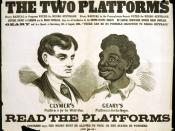Set in the 1930s, varying between a black college in the south and a place in Harlem, New York, Ralph Ellison's Invisible Man takes the reader through the journey of a man who seeks to act according to the values and expectations of his immediate social group, but seems to find himself unable to reconcile his socially imposed role as a black man with his inner concept of identity, or even to understand his inner identity. Ellison implores the reader to explore and tackle the sensitive subject of racism while requiring the reader to carefully examine themselves.
The narrator, an unnamed black man, writes the novel in the style of a memoir of his life consistently in first person, emphasizing individual experience and his feelings about the events portrayed. Ellison tends to write in a tone that often tends to blend with the sentiments of the narrator, ranging from bitterly cynical to willfully optimistic, from anguish at his sufferings to respect for the lessons learned from them.
While Ellison seems to portray himself through the narrator, he often displays the narrator as being blind to the realities of race relations during that time period. This is particularly illustrated during a fight at a brothel, a bar that typically serves black men. The narrator, after having driven him around campus, takes Mr. Norton, a white trustee at the college, to the bar. A fight breaks out among the mentally unstable black veterans and Norton passes out during the chaos. A veteran, claiming to be a doctor, taunts both Norton and the narrator for their blindness regarding race relations. Throughout the novel, there are several symbols that aid in the unfolding of the narrator's life. The Liberty Paints Plant where he was referred to by a trustee named Mr. Emerson, represents...

![[Portrait of Abe Most, Pete Ponti, Sid Jacobs, and Jimmy Norton, Hickory House, New York, N.Y., ca. June 1947] (LOC)](https://s.writework.com/uploads/9/94582/portrait-abe-most-pete-ponti-sid-jacobs-and-jimmy-norton-hi-thumb.jpg)
